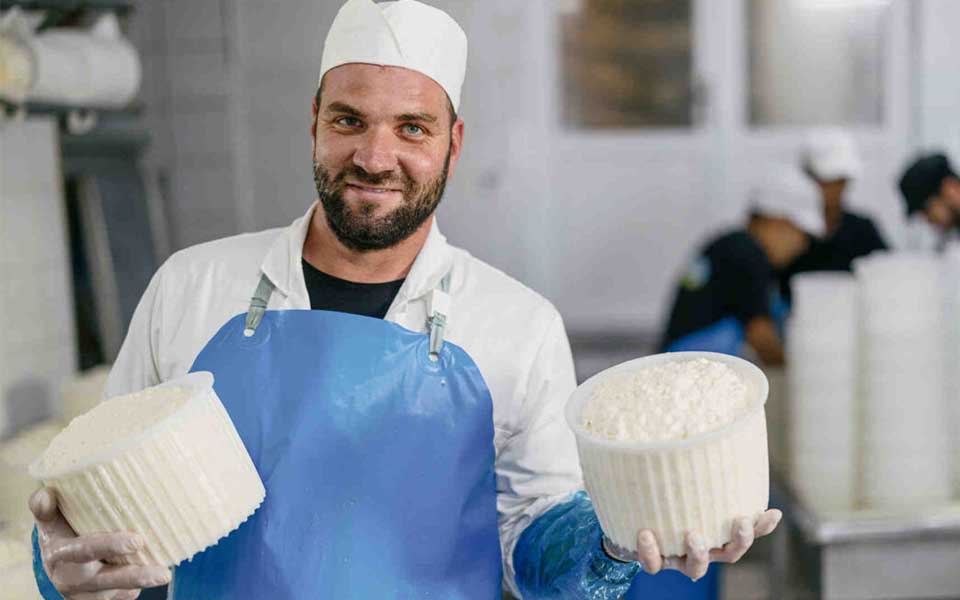For three generations, the Koukas family has been producing an outstanding version of the classic spicy Mykonos cheese known as kopanistí.
At 4:30 in the morning, when most people on Mykonos are still in full party mode, Thodoris Koukas starts his day by milking and feeding the animals before moving on to cheesemaking. He oversees and participates in every stage of production and often handles deliveries himself. “It’s important for me to have full control. There’s no other way. To achieve our goal, we must ensure that our cheeses, which are highly perishable, reach the consumer’s plate in perfect condition. All of this requires my attention,” he explains.
Over the years, the Koukas family has mastered the art of kopanistí. With knowledge, experience, and dedication, they have been crafting Mykonos’ spiciest cheese – an essential cornerstone of local cheesemaking – for three generations. Thodoris’ grandfather, a postman by trade, would deliver homemade kopanistí along with the letters he carried every time he traveled to Athens, but the family’s current cheese dairy in Ano Mera only began to take shape in 1985, when Thodoris’ father, Markos Koukas, started a cattle farm in the area known as Maou. Today, that enterprise is one of the largest cattle farms in the Cyclades, with 380 well-fed cows producing approximately 1,700 tons of milk annually. “We don’t use commercial animal feed,” Thodoris says, “only natural organic food, and the cows graze in the fields whenever possible.”

The Koukas family farm is one of the largest in the Cyclades.
© Angelos Giotopoulos
A recently installed advanced monitoring system ensures 24-hour surveillance of the animals, tracking their welfare and diet. The system is also connected to a modern milking parlor, equipped with milk-metering technology. These innovations help guarantee that the cows are healthy, and producing high-quality milk.
“I loved this work from a very young age. I remember how long it took for the kopanistí to mature – we could hardly wait for it to be ready, ” Thodoris says. “When we took the animals to graze on Delos, we would spread kopanistí on crispy bread with fresh tomato, olive oil, oregano and salt. At home, we paired it with grapes and watermelon.”

Filling the little baskets of the field worker.
© Christina Georgiadou
Thodoris has always taken cheesemaking very seriously. A graduate of the Dairy School of Ioannina, he entered the trade before he turned 20. Today, he continues the legacy of his grandparents, operating with both scientific expertise and a deep respect for tradition in order to produce the finest kopanistí. His family’s dairy also produces Mykonos tyrovolia and xinotyro, using only their own farm’s fresh milk.
“This work is tough but, thankfully, the island supports us, even though our products are much more expensive than industrial cheeses. We sell to eight out of ten Mykonos restaurants, and they absorb about 40% of our production.” Over time, the dairy expanded its product range to include creamy tsantila yogurt, smooth anthotyro, and a masterfully aged graviera cheese. The graviera, perfected over years, made a strong impression in a blind tasting held by the Greek food magazine Gastronomos, with particular mention being made of its striking sharpness and its rich, buttery flavor.

© Angelos Giotopoulos
“On Mykonos, we could have taken an easier route with greater financial gain – rather than tending cows, we could have gone into tourism,” Thodoris says. “I hope I can inspire my daughters to embrace this work because my biggest concern is what will happen to the dairy when I grow old.”
This cheesemaker is dedicated to his craft, and through his work, a different side of Mykonos is revealed – a more authentic Mykonos, with its long-held traditions, its natural bounty, and its pure flavors.
The 17th Quality Awards of Gastronomos were dedicated to the producers of the Cyclades. At a crucial crossroads in the history of the Cyclades, where various circumstances have limited engagement with the primary sector, the awards highlighted the exceptions—those who persist in working the land and tending to livestock, producing cheeses and traditional cured meats, cultivating native varieties, honoring Cycladic traditions, and steadfastly preserving the Cycladic way of life.
This article was previously published in Greek at gastronomos.gr.
INFO
Mykonos Dairy – Koukas, Paliokastro, Ano Mera, Mykonos
Tel. (+30) 22890.718.13
Their products can be found on Mykonos and in selected stores and delis in Athens, including AB Vasilopoulos, Thanopoulos, some large Sklavenitis stores, Miran, Koukas Ioannis, The Butcher Shop, I Sesoula tis Geitonias, Paradosi, and more.









